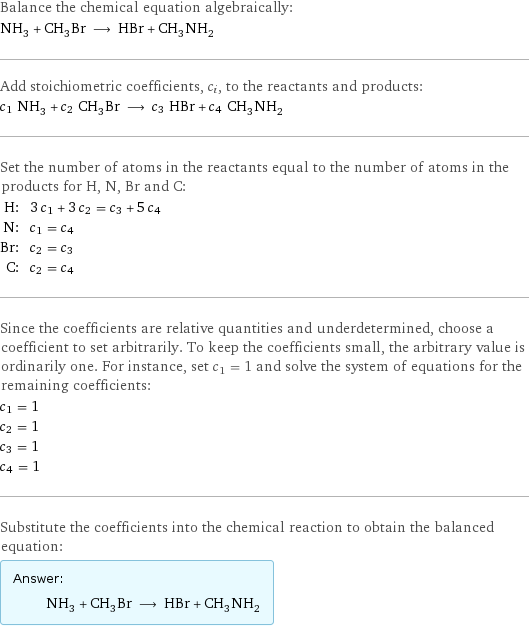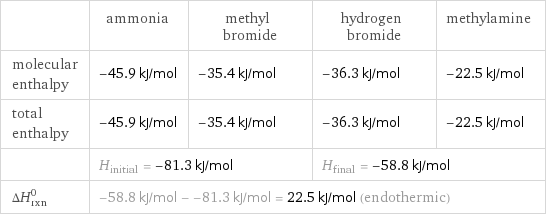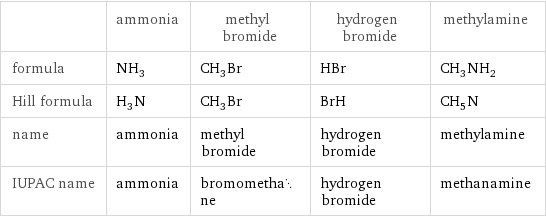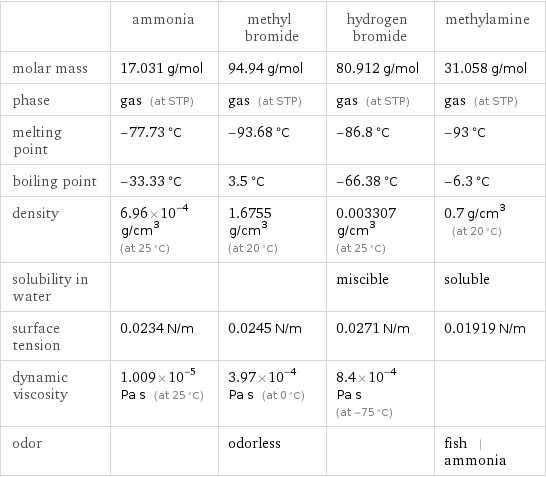Input interpretation

NH_3 ammonia + CH_3Br methyl bromide ⟶ HBr hydrogen bromide + CH_3NH_2 methylamine
Balanced equation

Balance the chemical equation algebraically: NH_3 + CH_3Br ⟶ HBr + CH_3NH_2 Add stoichiometric coefficients, c_i, to the reactants and products: c_1 NH_3 + c_2 CH_3Br ⟶ c_3 HBr + c_4 CH_3NH_2 Set the number of atoms in the reactants equal to the number of atoms in the products for H, N, Br and C: H: | 3 c_1 + 3 c_2 = c_3 + 5 c_4 N: | c_1 = c_4 Br: | c_2 = c_3 C: | c_2 = c_4 Since the coefficients are relative quantities and underdetermined, choose a coefficient to set arbitrarily. To keep the coefficients small, the arbitrary value is ordinarily one. For instance, set c_1 = 1 and solve the system of equations for the remaining coefficients: c_1 = 1 c_2 = 1 c_3 = 1 c_4 = 1 Substitute the coefficients into the chemical reaction to obtain the balanced equation: Answer: | | NH_3 + CH_3Br ⟶ HBr + CH_3NH_2
Structures

+ ⟶ +
Names

ammonia + methyl bromide ⟶ hydrogen bromide + methylamine
Reaction thermodynamics
Enthalpy

| ammonia | methyl bromide | hydrogen bromide | methylamine molecular enthalpy | -45.9 kJ/mol | -35.4 kJ/mol | -36.3 kJ/mol | -22.5 kJ/mol total enthalpy | -45.9 kJ/mol | -35.4 kJ/mol | -36.3 kJ/mol | -22.5 kJ/mol | H_initial = -81.3 kJ/mol | | H_final = -58.8 kJ/mol | ΔH_rxn^0 | -58.8 kJ/mol - -81.3 kJ/mol = 22.5 kJ/mol (endothermic) | | |
Equilibrium constant
![Construct the equilibrium constant, K, expression for: NH_3 + CH_3Br ⟶ HBr + CH_3NH_2 Plan: • Balance the chemical equation. • Determine the stoichiometric numbers. • Assemble the activity expression for each chemical species. • Use the activity expressions to build the equilibrium constant expression. Write the balanced chemical equation: NH_3 + CH_3Br ⟶ HBr + CH_3NH_2 Assign stoichiometric numbers, ν_i, using the stoichiometric coefficients, c_i, from the balanced chemical equation in the following manner: ν_i = -c_i for reactants and ν_i = c_i for products: chemical species | c_i | ν_i NH_3 | 1 | -1 CH_3Br | 1 | -1 HBr | 1 | 1 CH_3NH_2 | 1 | 1 Assemble the activity expressions accounting for the state of matter and ν_i: chemical species | c_i | ν_i | activity expression NH_3 | 1 | -1 | ([NH3])^(-1) CH_3Br | 1 | -1 | ([CH3Br])^(-1) HBr | 1 | 1 | [HBr] CH_3NH_2 | 1 | 1 | [CH3NH2] The equilibrium constant symbol in the concentration basis is: K_c Mulitply the activity expressions to arrive at the K_c expression: Answer: | | K_c = ([NH3])^(-1) ([CH3Br])^(-1) [HBr] [CH3NH2] = ([HBr] [CH3NH2])/([NH3] [CH3Br])](../image_source/b77112f0692ffea00dcf4cc1040600a1.png)
Construct the equilibrium constant, K, expression for: NH_3 + CH_3Br ⟶ HBr + CH_3NH_2 Plan: • Balance the chemical equation. • Determine the stoichiometric numbers. • Assemble the activity expression for each chemical species. • Use the activity expressions to build the equilibrium constant expression. Write the balanced chemical equation: NH_3 + CH_3Br ⟶ HBr + CH_3NH_2 Assign stoichiometric numbers, ν_i, using the stoichiometric coefficients, c_i, from the balanced chemical equation in the following manner: ν_i = -c_i for reactants and ν_i = c_i for products: chemical species | c_i | ν_i NH_3 | 1 | -1 CH_3Br | 1 | -1 HBr | 1 | 1 CH_3NH_2 | 1 | 1 Assemble the activity expressions accounting for the state of matter and ν_i: chemical species | c_i | ν_i | activity expression NH_3 | 1 | -1 | ([NH3])^(-1) CH_3Br | 1 | -1 | ([CH3Br])^(-1) HBr | 1 | 1 | [HBr] CH_3NH_2 | 1 | 1 | [CH3NH2] The equilibrium constant symbol in the concentration basis is: K_c Mulitply the activity expressions to arrive at the K_c expression: Answer: | | K_c = ([NH3])^(-1) ([CH3Br])^(-1) [HBr] [CH3NH2] = ([HBr] [CH3NH2])/([NH3] [CH3Br])
Rate of reaction
![Construct the rate of reaction expression for: NH_3 + CH_3Br ⟶ HBr + CH_3NH_2 Plan: • Balance the chemical equation. • Determine the stoichiometric numbers. • Assemble the rate term for each chemical species. • Write the rate of reaction expression. Write the balanced chemical equation: NH_3 + CH_3Br ⟶ HBr + CH_3NH_2 Assign stoichiometric numbers, ν_i, using the stoichiometric coefficients, c_i, from the balanced chemical equation in the following manner: ν_i = -c_i for reactants and ν_i = c_i for products: chemical species | c_i | ν_i NH_3 | 1 | -1 CH_3Br | 1 | -1 HBr | 1 | 1 CH_3NH_2 | 1 | 1 The rate term for each chemical species, B_i, is 1/ν_i(Δ[B_i])/(Δt) where [B_i] is the amount concentration and t is time: chemical species | c_i | ν_i | rate term NH_3 | 1 | -1 | -(Δ[NH3])/(Δt) CH_3Br | 1 | -1 | -(Δ[CH3Br])/(Δt) HBr | 1 | 1 | (Δ[HBr])/(Δt) CH_3NH_2 | 1 | 1 | (Δ[CH3NH2])/(Δt) (for infinitesimal rate of change, replace Δ with d) Set the rate terms equal to each other to arrive at the rate expression: Answer: | | rate = -(Δ[NH3])/(Δt) = -(Δ[CH3Br])/(Δt) = (Δ[HBr])/(Δt) = (Δ[CH3NH2])/(Δt) (assuming constant volume and no accumulation of intermediates or side products)](../image_source/d3d3abfd8755cab002925f7a6138dc0d.png)
Construct the rate of reaction expression for: NH_3 + CH_3Br ⟶ HBr + CH_3NH_2 Plan: • Balance the chemical equation. • Determine the stoichiometric numbers. • Assemble the rate term for each chemical species. • Write the rate of reaction expression. Write the balanced chemical equation: NH_3 + CH_3Br ⟶ HBr + CH_3NH_2 Assign stoichiometric numbers, ν_i, using the stoichiometric coefficients, c_i, from the balanced chemical equation in the following manner: ν_i = -c_i for reactants and ν_i = c_i for products: chemical species | c_i | ν_i NH_3 | 1 | -1 CH_3Br | 1 | -1 HBr | 1 | 1 CH_3NH_2 | 1 | 1 The rate term for each chemical species, B_i, is 1/ν_i(Δ[B_i])/(Δt) where [B_i] is the amount concentration and t is time: chemical species | c_i | ν_i | rate term NH_3 | 1 | -1 | -(Δ[NH3])/(Δt) CH_3Br | 1 | -1 | -(Δ[CH3Br])/(Δt) HBr | 1 | 1 | (Δ[HBr])/(Δt) CH_3NH_2 | 1 | 1 | (Δ[CH3NH2])/(Δt) (for infinitesimal rate of change, replace Δ with d) Set the rate terms equal to each other to arrive at the rate expression: Answer: | | rate = -(Δ[NH3])/(Δt) = -(Δ[CH3Br])/(Δt) = (Δ[HBr])/(Δt) = (Δ[CH3NH2])/(Δt) (assuming constant volume and no accumulation of intermediates or side products)
Chemical names and formulas

| ammonia | methyl bromide | hydrogen bromide | methylamine formula | NH_3 | CH_3Br | HBr | CH_3NH_2 Hill formula | H_3N | CH_3Br | BrH | CH_5N name | ammonia | methyl bromide | hydrogen bromide | methylamine IUPAC name | ammonia | bromomethane | hydrogen bromide | methanamine
Substance properties

| ammonia | methyl bromide | hydrogen bromide | methylamine molar mass | 17.031 g/mol | 94.94 g/mol | 80.912 g/mol | 31.058 g/mol phase | gas (at STP) | gas (at STP) | gas (at STP) | gas (at STP) melting point | -77.73 °C | -93.68 °C | -86.8 °C | -93 °C boiling point | -33.33 °C | 3.5 °C | -66.38 °C | -6.3 °C density | 6.96×10^-4 g/cm^3 (at 25 °C) | 1.6755 g/cm^3 (at 20 °C) | 0.003307 g/cm^3 (at 25 °C) | 0.7 g/cm^3 (at 20 °C) solubility in water | | | miscible | soluble surface tension | 0.0234 N/m | 0.0245 N/m | 0.0271 N/m | 0.01919 N/m dynamic viscosity | 1.009×10^-5 Pa s (at 25 °C) | 3.97×10^-4 Pa s (at 0 °C) | 8.4×10^-4 Pa s (at -75 °C) | odor | | odorless | | fish | ammonia
Units
